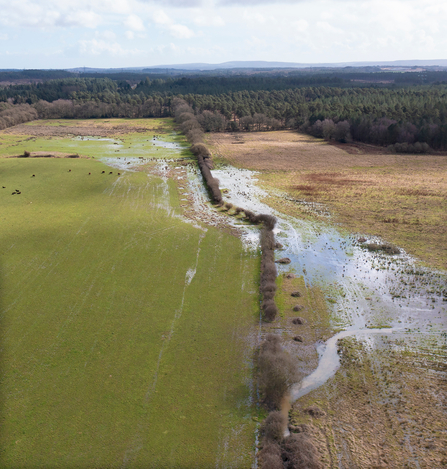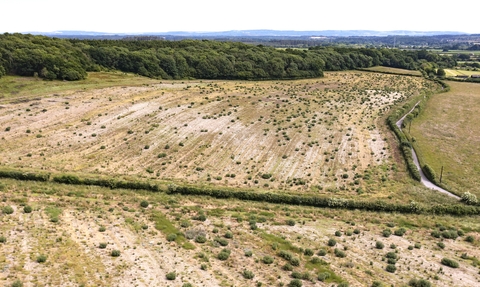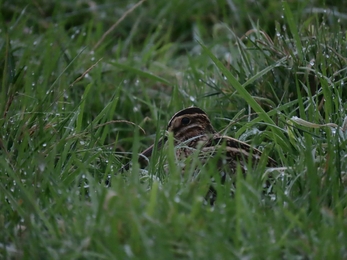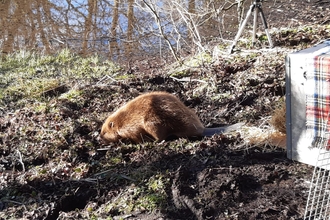Seb Haggett / A mating pair of silver-studded blues was seen on site this year, along with other individuals. New to the site, the abundance of common bird's foot trefoil and gorse at Wild Woodbury is thought to have attracted the butterflies.
Wild Woodbury
Making space for wildlife in Dorset
Over four years into Dorset Wildlife Trust's community rewilding project at Bere Regis and we are celebrating the introduction of free-roaming livestock to the site, the benefits of the landscape-changing Stage-0 river restoration work for wetland wildlife, an improvement in water quality, and the inspiring community efforts.
We are grateful for the support of Julia Davies, founder of We Have the POWER who helped to acquire this site in September 2021 through her Funding Nature Project and is currently working with The Wildlife Trusts to develop the philanthropic lending concept. Find out more about philanthropic loans and Julia's story here
Livestock introduced onto the site
As we entered into the third year of our community rewilding project, we were delighted to introduce free-roaming livestock onto Wild Woodbury. We have partnered with our neighbouring farmer to deliver this phase of the project. Our aim is to access all the ecological benefits the grazing brings, whilst showcasing a financially sustainable business model for our grazier.
Free-roaming livestock have multiple benefits for the landscape and wildlife on the site. Through their natural habits of browsing, grazing, and rootling, they create a dynamic system of competition between scrub growth and grazing, which in turn produces a robust and ever-changing mosaic of habitats to support biodiversity and bio abundance.
First, we introduced six original population Hereford cattle. Their presence has contributed to nature's recovery at Wild Woodbury, balancing their selective grazing against natural succession. The next phase of livestock introduction was the addition of five Exmoor ponies over the winter. The addition of more large herbivores has helped to create a dynamic landscape, whether that be from their dust bath creation or their impact on species such as bracken. Lastly, we introduced two Mangalitsa/Berkshire cross pigs to Wild Woodbury. The pigs have been rootling to create bare ground and helping to disperse seeds throughout the site.
Species abundance
Whilst not immune from the terrifying drop in insect numbers we have seen across the UK this year, Wild Woodbury remains a stronghold for wildlife in and around Bere Regis.
In the three years since the land was acquired, over 1,900 species have been recorded at Wild Woodbury - an uplift of 600 species since our first year surveys. Small mammals have been thriving on site, with harvest mice, water shrew and field voles now a common sight to be seen scurrying through the undergrowth. Water shrew in particular have benefitted from last year's Stage-0 river restoration, hunting caddisfly and mayfly larvae in the newly created wetland pools across the site.
The increase in abundance of small mammals has benefitted reptiles and birds of prey. We have now recorded four out of the UK's six native reptiles on site: slow worm, grass snake, adder, and common lizard. In particular we have been amazed by the speed of the adder in spreading across the site. These species have undoubtedly gained from the increased cover and plentiful food. Similarly, birds of prey have been thriving across the site. Species spotted in the third year include: buzzard, kestrel, red kite, sparrow-hawk, hobby, peregrine falcon, goshawk, osprey, white-tailed eagle, hen harrier and short-eared owl.
Regular bird ringing sessions throughout the third year have also been encouraging. 40 different species were ringed, totaling 492 birds in the third year alone. New species ringed in year three include the nightingale, pied flycatcher, ring ouzel, treecreeper and wryneck. 29 birds on the Red List for Birds of Conservation Concern have now been recorded on site, with 12 of them now breeding on Wild Woodbury.
Changes to the landscape
It has been over a year since the Stage-0 river restoration work was completed, and the difference it has made to the site has been incredible. Suddenly, the water has been able to follow its natural path through the lower ground.
This winter, after heavy rainfall, water was able to meander across the site, creating various streams and pools. The saturated ground allowed for wetland-loving rushes to thrive. In turn, this has attracted a host of wetland birds to Wild Woodbury. Lapwing, common snipe, and Jack snipe were spotted in large numbers throughout the winter months, drawn by the new wetland habitat created.
In the spring, clumps of frogspawn appeared across the site, followed by many young frogs and toads. Frogs in particular had previously been noticeable by their absence on site. Wetland invertebrates have occupied every water body, including golden-ringed dragonfly nymphs, diving beetles, and freshwater shrimp.
The landscape has been transformed into a functioning ecosystem. New plants have arrived on site, including the rare yellow bartsia, sun spurge, and sharp-leaved fluellen. Nitrogen-loving species, such as spear thistle, are starting to reduce in their size, a clear sign that the soil on site is starting to recover. Across the site, we are seeing the establishment of bramble, blackthorn and hawthorn, which in turn are providing cover for oak, ash and willow saplings.
Improvements to water quality and soil health
Thanks to the Stage-0 river restoration work in the second year, the water quality has now improved on the site.
Regular water testing, conducted through taking monthly water samples across the site, has shown that levels of nitrogen, phosphorous and suspended solids have decreased across Wild Woodbury, helping to prevent these nutrients from entering internationally significant Poole Harbour. High levels of nutrients in our water courses enable algae to thrive and create algal mats. These starve the water below of oxygen and therefore have a negative impact on the flora and fauna living there.
Another thing we were excited to monitor as the land rewilded was the soil health on the site. Much of the land at Wild Woodbury was previously more intensively managed than it is now. Ploughing not only breaks down and degrades the ecology within soils but also releases carbon. Inputs and heavy machinery also impact the soil's ability to hold water, life and carbon. Three years in, we have repeated our soil sampling that we first baselined in 2021. We should stress that much more data is needed for any degree of confidence but our initial data suggests that carbon stored in the soils on site has already increased, even in such a short space of time.

Roger Bates
Community engagement and accessibility
Another major development on the site in the third year was the new car park and opening of 13ha of community open access land. This was funded by Dorset Council as a strategic SANG (Suitable Alternative Natural Green Space).
Opened in 2024, this gives the community more access to natural green space on their doorstep. This area is being left to naturally regenerate to scrub and woodland, and has a mixture of accessible and cut paths throughout, leading to feature areas including the food forest, wild flower meadow and in the future, a wild play area is planned for this space. This has helped facilitate our first Accessible Guided Members' Walks at Wild Woodbury this summer. These walks were designed to give members with limited mobility the chance to enjoy a walk of this new space and more accessible areas of the site, guided by Wild Woodbury Ranger, Daisy.
The new carpark was also laid to improve accessibility to Wild Woodbury. And the installation of interpretation boards are educating visitors about our vision for the site, as well as aiding with navigation.
In 2024 we also introduced a series of walks called 'An Introduction to Rewilding'. These events have been fully booked and have proven extremely popular with our members and supporters. The walks were a great opportunity for us to show members of the public around the site and discuss the principles of rewilding.
FAQs
How have you engaged with the community?
Launching a rewilding project on the doorstep of Bere Regis opened up a unique opportunity for Dorset Wildlife Trust to involve the community - from organising bug hunts for local schoolchildren to open days and leading guided walks around the site. Many local people have volunteered to help with surveys, take photographs and share their memories of wildlife that used to be on the site.
The Community Liaison Group and an online poll of residents have helped to formulate the plan for the open access area which will include a food forest, free for the public to walk through and pick as they go as well as woodlands, a wild play and wildflower picnic meadows, a community table to seat 60 people and of course lots of footpaths and trails throughout the space.
Dorset Wildlife Trust is working with students and researchers from Bournemouth University and UWE who are conducting surveys and analysing the data being collected. This will be a long-term project to assess change in the landscape over the next decade and beyond.
Can I visit Wild Woodbury?
There is a waymarked walking trail around the Wild Woodbury site and a car park at the main entrance. There are also footpaths and public rights of way across the land which are open to everyone. Vehicle access is from Southbrook, Bere Regis, BH20 7LL and the what3words location for the main entrance is: ///pesky.indicates.stubble
Why did you buy this land?
There were three key reasons for purchasing this land. First is tackling the ecological crisis. The Wildlife Trusts want to see 30% of land being managed in a way which is beneficial to nature in the UK by 2030. This means some currently nature-poor areas need to be restored to allow nature space to rebound and spread.
Second is tackling the climate crisis. Restoring nature increases the amount of carbon held in healthy soils, new woodlands and wetlands and reduces outputs of harmful greenhouse gases.
Third, we aim to help local communities better connect with nature on their doorstep. More of us than ever are disconnected from the natural world but connection to nature has huge benefits for mental and physical wellbeing. This site will provide vital space and new opportunities to engage the public with the natural world. Dorset Wildlife Trust is working closely with the local community with planning for the site’s future, to ensure their voices are heard and they receive real community benefits.
How was the acquisition funded?
Julia Davies , environmental campaigner and founder of We Have The POWER played a major role in making the acquisition possible, by initiating and negotiating the purchase on behalf of Dorset Wildlife Trust, giving us time to secure funds. Find out more about her Funding Nature Project.
We were very grateful to receive funding from both BCP and Dorset Councils for this project, to mitigate the impacts of increases in nitrates due to new housing development in the Poole Harbour catchment.
Supporters of Dorset Wildlife Trust made generous donations to the project and our thanks go to those who pledged money in their Wills to support the purchase of land.
Why are nitrates such a problem?
High levels of nitrates in our waterways cause algal blooms which can kill ecosystems and have a devastating effect on the wider food chain. Nitrates predominantly come from fertiliser and manure that has been used in agriculture and then washed into waterways and, to a lesser extent, treated sewage. The high levels of these nutrients flowing into Poole Harbour mean that any new input, such as from new houses, has to be balanced by reductions in the same catchment. By taking this land out of intensive farming, the levels of nitrates will be reduced over time.
One year on
A year into Dorset Wildlife Trust's Wild Woodbury community rewilding project at Bere Regis and surveys recorded an uplift in the biodiversity and abundance of species moving onto the 170 hectare site. Since the land was acquired in 2021, it was allowed to naturally regenerate with remarkable results. At the end of the first year, staff and volunteers recorded over 1,300 species in the summer surveys and eight Red List birds of conservation concern were confirmed to be breeding at Wild Woodbury.
Wild Woodbury One Year On (https://youtu.be/4JaxYyRnO6g)
Dani Wilson / Wild Woodbury one year on
Two years on
Stage-0 River Restoration
A major part of rewilding is the restoration of natural processes, which for us at Wild Woodbury meant a site-wide project to re-naturalise the headwaters of the River Sherford. Stage-0 in the river restoration process is simply water flowing across the landscape; water that is not diverted or constrained into channels and ditches, but can freely flow into the low ground, finding natural pathways and re-establishing historic routes through fields. To achieve this, we strategically filled in ditches to push water out into the fields, before supplementing this work by blocking up field drains and creating leaky dams throughout the remaining ditch systems. The effect of the restoration has been both immediate and incredible to witness, with a once dry and cracked landscape now a heterogeneous mixture of large flows, ephemeral pools, and delta-like areas. This wetland system makes the land much more resilient to drought, filters excess nutrients out of the water, helps to alleviate flash flooding downstream, and will provide habitats and space for biodiversity and bio abundance to increase. Just a few weeks after the restoration had finished, we played host to 90 lapwing, 20 golden plover, and 30 common snipe, all feeding in the newly wetted areas.
Wildlife thriving at Wild Woodbury
Volunteers have once again been crucial to our progress this year, with over 1,500 volunteer hours logged for both practical work and species surveys. Days have been varied, including the pulling of non-native species such as bamboo and buddleia, installing new signage, and planting out the one 1-hectare community food forest. During surveys, staff and volunteers have seen a huge increase in both biodiversity and bio abundance, with the site list now over 1600 species, an increase of 300 from the previous year.
Many new species have colonised the site, and several Red-listed and Red-data Book species, including marsh tit and greenfinch, are using the site to breed, helping smaller populations build resilience, as well as increasing numbers of more common species. Perhaps the most exciting discovery of this year’s summer surveys was the nightingale, another visitor on the Red List for birds of conservation concern. Though not confirmed to be breeding on site, its presence at Wild Woodbury as it migrates southwards is extremely encouraging. Hopefully, they will return next spring to breed!
The upward trend in ground nesting bird numbers continues from year one, with skylark now at around 50 pairs compared to 18 in 2022, tree pipit increasing from one to seven pairs, and nightjar holding new territories. Reptiles are moving back in, with adder now confirmed to be breeding, and an uplift of grass snake, slow worm, and common lizard populations on site. Our invertebrate numbers continue to grow, with butterflies showing around a 25% increase in abundance, including the colonisation and breeding of silver-studded blues, a butterfly usually associated with wet heath habitats.
The increase in diversity and abundance has included several other species which have also been a surprise whilst recording on site. Nightjar, known for usually being on heathland, moorland, and woodland clearings, have been holding territories on site, possibly breeding this year, but certainly will be in the coming years if not. Common hemp nettle has been rapidly taking advantage of new bare ground and spreading across large areas, whilst the grayling butterfly has also been exploiting bare ground to bask in the sun. The once thought extinct speckled footman was trapped during moth surveying, and the endangered Red Data Book beetle Hylis cariniceps was recorded in a vane trap. As the site rewilds further, I imagine that future surveys will continue to surprise us.
Community Engagement
The increase in biodiversity has allowed for the team to facilitate more wildlife-themed events and activities on site for the public to get involved with. In May we ran guided Dawn Chorus walks and attendees were able to enjoy the sound of birdsong and learn about how the diversity of birds has changed since we purchased the site in 2021. Wilder Dorset Ranger, Seb Haggett, has also been busy running moth trapping events throughout the summer. Visitors were treated to glimpses of a whole host of moth species that now call Wild Woodbury home, including the poplar, privet and elephant-hawk moths.
The one-hectare food forest, planted by volunteers and the Bere Regis Scouts, is made up of around 200 mixed fruit trees and bushes, which will be free for the public to come and pick in the coming months and years. Not only will this food forest help provide local and sustainable food for the nearby residents, but it also presents a future opportunity for ongoing engagement through a variety of events. This food forest is also going to add to the diversity of habitats on site, supporting different species and allowing us to further build on the species data and future recovery of wildlife.
The Making of Wild Woodbury by Susan Western
Over the past year, we have been working with the incredibly talented wildlife film maker and producer Sue Western to document the inspiring story of Wild Woodbury so far.
To start the rewilding process, we had to reinstate natural processes on site, firstly letting the site rest and preparing it for the introduction of mixed grazing, and then carrying out Stage-0 river restoration to renaturalise the headwaters of the river. All whilst carrying out extensive surveys to see how the abundance and diversity of species has been changing. The site was also visited by pupils from Bere Regis primary school on a mission to collect acorns ready to plant what will be the start of the ambitious Oak Henge Project.
We hope you enjoy this beautiful video.
Wild Woodbury species reports
The Wild Woodbury project was supported by the Green Recovery Challenge Fund, with the wetland restoration work enabled by support from Montanaro Asset Management. Dorset Wildlife Trust received a land purchase grant from Bournemouth, Christchurch and Poole Council and Dorset Council for land management changes which remove nitrogen inputs. This enables the Councils to meet their duties to mitigate for inputs from development in Poole Harbour catchment and ensure there is no further deterioration of water quality in the harbour. The Councils are supporting a nature-based approach to nutrient mitigation which also delivers for nature recovery, natural flood management and local communities.
Sign up for our e-newsletter
If you're interested in hearing more about the Wild Woodbury project or would like to keep up-to-date with all our wildlife news, why not subscribe to our e-newsletter.

Roger Bates

















